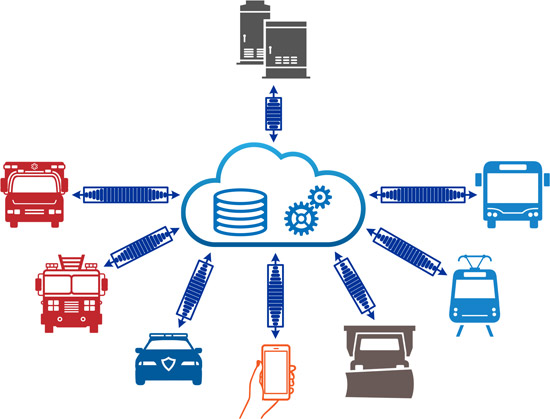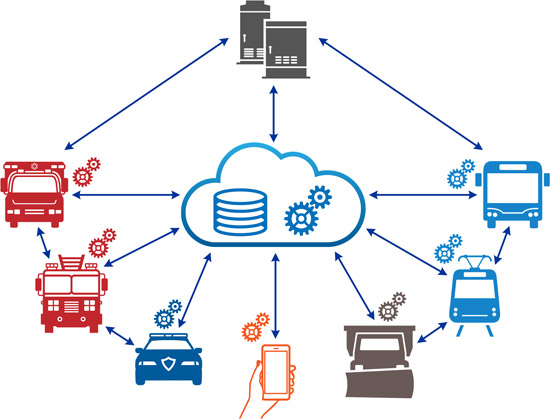March 31, 2021 – With the remarkable shift to cloud computing during the past decade, it’s nearly impossible to identify real-time technologies that don’t utilize the cloud to least some degree. However, for all of its advantages, cloud computing does have some inherent limitations. In most cases, these limitations are fairly minor, but they can decrease performance enough that safety-related agencies are well served by considering communications choices early in their project timeline.
About Cloud Computing
Cloud computing is simply the delivery of on-demand computing services over the internet. These services may include Servers, Databases, Networks, Development Tools, and Applications. Cloud computing benefits include:
- Cost: Cloud services are often pay-as-you-go, where you pay only for what you use.
- Measured Service: Cloud services can greatly reduce the need for maintaining servers and software.
- Scalability: An organization can scale its resource usage levels up or down quickly and easily as needs change.
- Security: Depending on an organization’s existing level of IT security, the cloud may offer greater controls to protect data, apps, and infrastructure from potential threats.
- Data Reliability: Data can typically be mirrored at multiple redundant sites on the cloud provider’s network.

About Edge Computing
With edge computing, computation (and oftentimes data storage) is performed in the field—by the devices producing or consuming that information. Edge computing was developed to allow the growing number of IoT devices to connect to the internet for the transfer of data to and from the cloud. Edge computing benefits include:
- Communications Reliability: Edge computing reduces the communications complexity by offering a more direct path between computing devices.
- Speed: The more direct path between devices also reduces the latency customary to network communications.
- Bandwidth: Edge computing allows for reduced bandwidth use by transferring only relevant and required data to the cloud.
- Long-Term Cost: Because cloud services are typically based on usage, reducing bandwidth often equals lower overall costs.

In transportation applications—particularly Emergency Vehicle Preemption—communications speed is essential. A two or three-second latency delay can easily result in still longer delays in actual response time. For agencies utilizing Collision Avoidance to alert drivers of potential collisions, any kind of delay can become a serious liability.
In transportation applications—particularly Emergency Vehicle Preemption—communications speed is essential. A two or three-second latency delay can easily result in still longer delays in actual response time. For agencies utilizing Collision Avoidance to alert drivers of potential collisions, any kind of delay can become a serious liability.
Transportation applications are perfect for utilizing Edge computing because of its reduced latency, but also due to reduced bandwidth amounts. Vehicles can generate an enormous amount of data, and bandwidth costs can very easily exceed estimates. However, with Cloud and Edge computing, it’s not necessarily a choice between one or the other.
The ideal way to implement an ITS system is with a combination of Cloud and Edge computing. While en route, vehicle devices should be capable of processing and prompting vehicle reactions on their own, while sending only a limited amount of data to the cloud. They can then send more detailed information during vehicle downtime at the station or yard. Wayside devices, such as intersection detectors, may also transfer activity data via the cloud or traffic network as needed.
There are other transportation applications where the speed and bandwidth advantages of Edge computing aren’t as critical, such as with the EMTRAC mobile apps. These apps enable passive detection of bicycles or pedestrians while utilizing the Cloud for a greater amount of processing than what is performed for first-response applications.
Transit agencies may also opt for cloud computing since latency delays are not typically lengthy enough to create problems for applications such as Transit Signal Priority (TSP).
The EMTRAC system uses Edge Computing where it’s needed—onboard for speed and reliability, and the cloud where it’s needed—for centralized accessibility. With the EMTRAC system, your “cloud” can be located wherever you prefer, at your own data center, at the EMTRAC data center, or at a third-party data center.
Each ITS project is different, and the EMTRAC system is designed to work for all of them. Please contact us to learn more about how other EMTRAC-equipped cities have handled device computing, as well as how the EMTRAC system can work for your upcoming project.
